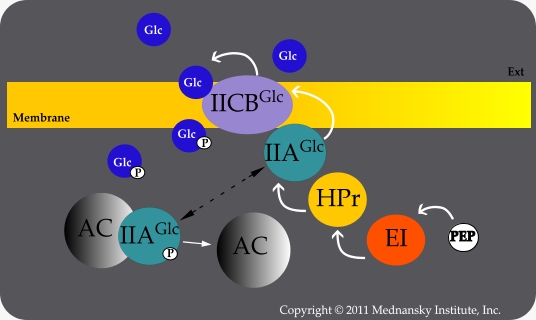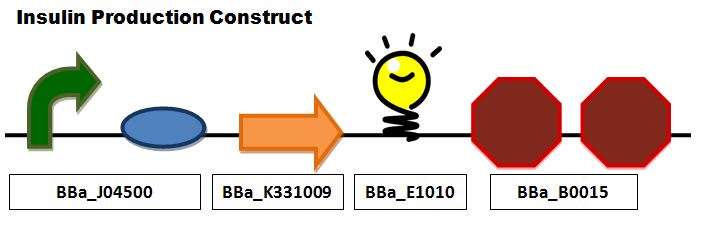Team:Lethbridge Canada/The Project
From 2012hs.igem.org
(→Treating type I diabetes: A synthetic biology approach) |
|||
| Line 33: | Line 33: | ||
Hyperglycemic diabetes mellitus (type I diabetes) is a disorder in which pancreatic beta (insulin-producing) cells within the body are compromised, and results in the inability of the body to control glucose levels. Conventional methods of treatment can have unfavorable implications. Therefore, our team worked on using synthetic biology to derive another, potentially more viable treatment. | Hyperglycemic diabetes mellitus (type I diabetes) is a disorder in which pancreatic beta (insulin-producing) cells within the body are compromised, and results in the inability of the body to control glucose levels. Conventional methods of treatment can have unfavorable implications. Therefore, our team worked on using synthetic biology to derive another, potentially more viable treatment. | ||
| - | Our project involves engineering a glucose detection and insulin production/secretion system. As a method of glucose detection, we are utilizing the natural mechanism of glucose-induced gene expression present in Escherichia coli — mlc inhibition coupled with the phosphotransferase system. The induced gene will be red fluorescent protein (RFP) as a proof of principle in place of insulin. In order to secrete insulin (or RFP respectively), we will use N-terminal signal sequences to direct targeting across the cell membrane. We are testing two—twin arginine tag and heat-stable toxin I— to determine their efficiency in secreting proteins. | + | Our project involves engineering a glucose detection and insulin production/secretion system. As a method of glucose detection, we are utilizing the natural mechanism of glucose-induced gene expression present in ''Escherichia coli'' — mlc inhibition coupled with the phosphotransferase system. The induced gene will be red fluorescent protein (RFP) as a proof of principle in place of insulin. In order to secrete insulin (or RFP respectively), we will use N-terminal signal sequences to direct targeting across the cell membrane. We are testing two—twin arginine tag and heat-stable toxin I— to determine their efficiency in secreting proteins. |
'''Diabetes''' <br> | '''Diabetes''' <br> | ||
| - | The purpose of our project is to create bacteria that will detect blood sugar levels and respond accordingly by producing insulin. Type one diabetes is caused by the degeneration of islet cells in the pancreas. Conventional methods of treatment for type one diabetes include direct injection of insulin intravenously, the transplantation of islet cells or even the introduction of an entirely new pancreas. Our engineered bacteria would provide a long-term solution compared to the standard injections, which need to be administered at least twice per day. In essence, our project has the potential to change the way that diabetes is treated. | + | The purpose of our project is to create bacteria that will detect blood sugar levels and respond accordingly by producing an appropriate amount of insulin. Type one diabetes is caused by the degeneration of islet cells in the pancreas. Conventional methods of treatment for type one diabetes include direct injection of insulin intravenously, the transplantation of islet cells or even the introduction of an entirely new pancreas. Our engineered bacteria would provide a long-term solution compared to the standard injections, which need to be administered at least twice per day. In essence, our project has the potential to change the way that diabetes is treated. |
Worldwide 346 million people suffer from diabetes, including 2.7 million people in Canada. In higher income countries diabetes usually affects people over 50 years of age the most. Lower income countries face double the mortality rate when compared to the higher income countries as a result of diabetes. Diabetes can give someone a predisposition to heart disease and 4 out of 5 diabetic patients die from heart disease. 1 in 3 people who have diabetes are unaware they have it, on average people have diabetes for 7 years before diagnosis. The cost of medication and supplies range from 1,000 to 15,000 dollars every year. It is estimated that diabetes will cost the Canadian health care system 19.2 billion dollars by 2020. | Worldwide 346 million people suffer from diabetes, including 2.7 million people in Canada. In higher income countries diabetes usually affects people over 50 years of age the most. Lower income countries face double the mortality rate when compared to the higher income countries as a result of diabetes. Diabetes can give someone a predisposition to heart disease and 4 out of 5 diabetic patients die from heart disease. 1 in 3 people who have diabetes are unaware they have it, on average people have diabetes for 7 years before diagnosis. The cost of medication and supplies range from 1,000 to 15,000 dollars every year. It is estimated that diabetes will cost the Canadian health care system 19.2 billion dollars by 2020. | ||
Revision as of 03:42, 17 June 2012

| Home | The Team | The Project | Results | Human Practices | Notebook | Safety |
|---|
Treating type I diabetes: A synthetic biology approachHyperglycemic diabetes mellitus (type I diabetes) is a disorder in which pancreatic beta (insulin-producing) cells within the body are compromised, and results in the inability of the body to control glucose levels. Conventional methods of treatment can have unfavorable implications. Therefore, our team worked on using synthetic biology to derive another, potentially more viable treatment. Our project involves engineering a glucose detection and insulin production/secretion system. As a method of glucose detection, we are utilizing the natural mechanism of glucose-induced gene expression present in Escherichia coli — mlc inhibition coupled with the phosphotransferase system. The induced gene will be red fluorescent protein (RFP) as a proof of principle in place of insulin. In order to secrete insulin (or RFP respectively), we will use N-terminal signal sequences to direct targeting across the cell membrane. We are testing two—twin arginine tag and heat-stable toxin I— to determine their efficiency in secreting proteins.
Worldwide 346 million people suffer from diabetes, including 2.7 million people in Canada. In higher income countries diabetes usually affects people over 50 years of age the most. Lower income countries face double the mortality rate when compared to the higher income countries as a result of diabetes. Diabetes can give someone a predisposition to heart disease and 4 out of 5 diabetic patients die from heart disease. 1 in 3 people who have diabetes are unaware they have it, on average people have diabetes for 7 years before diagnosis. The cost of medication and supplies range from 1,000 to 15,000 dollars every year. It is estimated that diabetes will cost the Canadian health care system 19.2 billion dollars by 2020. -http://www.diabetes.ca/getserious/facts
Sensory transduction is a mechanism used by many organisms to monitor their external environments. E. coli detects changes in glucose levels in its environment by means of phosphotransferase system (PTS). This system uses E. coli’s enzyme II, which consists of the membrane-bound protein EIICBGlc, as well as enzyme I (EI), a histidine phosphocarrier protein HPr, and another protein called EIIAGlc. Enzyme II is responsible for the phosphorylation and transportation of glucose into the cell. Mlc is a repressive protein that binds to a specific DNA sequence and prevents it from being transcribed. This regulates the transcription of specific genes so certain proteins are only made when they are needed. This is the mechanism we are going to use to regulate the transcription of the gene for insulin. When glucose enters the cells via enzyme II, it picks up a phosphoryl group that was originally bound to EIICBGlc. The dephosphorylated form of EIICBGlc has a high affinity with Mlc and recruits MCL from its binding site on the DNA sequence. The gene is now free to be transcribed. Due to the fact that this sequence is originally stimulated by an increase in glucose concentration as it enters the cell, it is the perfect circuit for us to use to regulate the production of inulin. Nam, T., Cho, S., Shin, D., Kim, J., Jeong, J., Lee, J., Roe, J., & Kang, S. (2001). The Escherichia coli glucose transport enzyme iicb(glc) recruits the global repressor mlc.
Insulin Production and Secretion
Delivery System
|
 "
"



